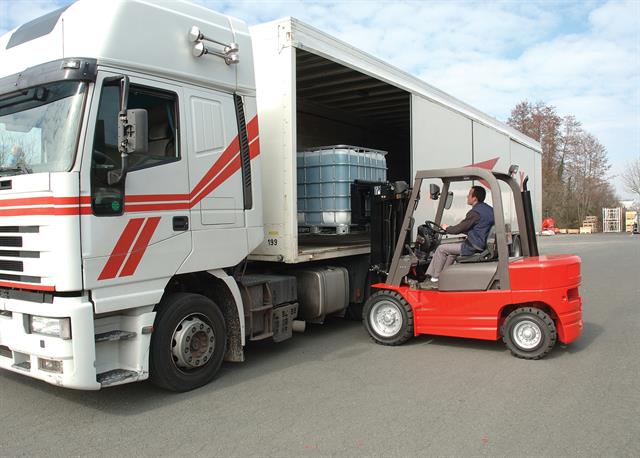 Stuart Taylor |
Stuart Taylor is Managing Director of Mentor FLT Training Limited, the UK's leading provider of training and associated services for all types of materials handling equipment and workplace transport.
The risk of accidents and serious injuries increases dramatically whenever forklifts and pedestrians work in the same space, so the arrival of delivery drivers into busy loading areas needs careful management.
Here we have outlined some simple steps you can take to avoid common hazards during loading operations.
1. Keep a safe distanceIt is no surprise that delivery drivers often want to help when their vehicles are being loaded - after all, it is their responsibility to ensure the security of their load and they may have a preferred order for unloading at the other end.
However, while they can specify their requirements, they should not be allowed in the loading area and must remain in a safe position while the forklift is in operation. Trying to help the process along either by holding back a curtain, steadying a load or directing from alongside puts them in real danger should a load be lost or the operator lose sight of them. And the serious injuries caused are almost always avoidable, because the pedestrian should never be in the operating area in the first place.
 Many accidents and injuries can be avoided |
In recent years, one UK company was fined GBP1.2 million (USD1.65 million) after a HGV driver was fatally crushed when an overloaded forklift truck overturned. The resulting investigation found that the forklift had been unloading a 2.2 T load (42% over its maximum operational capacity), causing the truck to tip. It also found that there was no procedure in place to keep pedestrians a safe distance from loading/unloading operations.
Such segregation measures are vital because a safe distance will ensure waiting drivers are not injured, should there be unsafe operating methods.
Safety step: Ensure you have adequate segregation measures to keep delivery drivers and other pedestrians a safe distance away from forklifts. Physical measures such as barriers as well as pedestrian areas and walkways can be used to help the relevant parties to remain in a safe space.
Of course, you should never find delivery drivers in unsafe positions if there are relevant safety policies in place that are communicated and followed, which brings us to our next step ...
2. Implement a clear Safe System of WorkProducing risk assessments and the resulting Safe Systems of Work (SSOW) plays a crucial role in ensuring that all hazards associated with tasks such as loading and unloading are eliminated or the risks sufficiently minimised. Though SSOW can significantly reduce the number of accidents on site, all too often, companies do not have these in place.
In another recent incident, a UK manufacturer was fined GBP38,000 (USD50,000) when an HGV driver was seriously injured during unloading, after being trapped between a falling load and his own vehicle. The HSE found that there was no SSOW for unloading or loading and no rules for visiting drivers on where to wait.
Safety step: Establish and share your SSOW, then ensure that management continually enforces them (this follow up is crucial to effectively reducing risk). Make sure that delivery drivers are fully briefed to follow any parts that apply to them. This could include:
· A designated waiting area for drivers, away from the loading area, or other specified safe locations e.g. in the cab with the engine off.
· A key control system where drivers hand over their vehicle keys until loading is complete (to limit the temptation to return to the vehicle during loading).
SSOW are a vital tool to keep sites safe, but are only effective if they are followed. Companies' good intentions can often be thwarted if you don't complete the final step...
3. Communicate safety to everyone on siteSometimes, SSOW may be in place but either they are not followed or not conveyed to everyone who could be affected - including visiting drivers. This undermines any good work done to reduce risk for those involved in the task.
As an additional measure, methods such as 'Show Your Hand' can be used to standardise communication between forklift operators and those around them on foot. Operators can use this to alert delivery drivers or other pedestrians if they are coming too close to the truck, and signal to them that they must stop, as follows:
Step 1. If a pedestrian is coming too close, stop the truck.
Step 2. 'Show your hand' to signal them to stop.
Step 3. If they do not stop, turn off the ignition to reduce the risk.
Safety step: Managers have a responsibility to communicate SSOW to everyone who could be affected, including any visiting personnel, so that safety procedures can be adhered to (e.g. via briefings, training, safety meetings, signage, regular monitoring).
Many accidents and injuries can be avoided if we understand the risks and how to avoid them. Keeping everyone informed and providing the relevant training for operators and pedestrians alike will help all those who work on or around forklift trucks to stay safe. Those overseeing operations also have a vital role to play in monitoring and enforcing your companies' policies and procedures. Ensure they know how to meet their responsibilities for safety with training for managers and supervisors on how to uphold best practice.